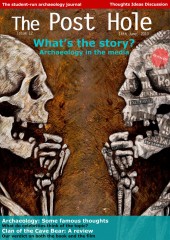For me, the word calls to mind rare evenings when my mum let us eat dinner in front of the television. The series was one of many things which led me to have a fascination with the Classics and ancient history. For those of you who were unlucky enough (or not quite geeky enough) to have never seen the series, I'll give you a very brief overview. 'Xena: Warrior Princess' follows the adventures of Xena (unsurprising) and her irritating, blonde sidekick Gabrielle as they wander through a mythic landscape which spans thousands of miles and several millennia (Weisbrot 1998: 228). They encounter gods, fight in the Trojan way and meet historical figures like Julius Caesar and the Greek poet, Homer. The series draws from classical mythology, literature and even historical events. It is perhaps unsurprising therefore that archaeology is also dragged into it. In fact, there is a whole episode dedicated to it.
'The Xena Scrolls' is an episode set in the 1940s and stars Lucy Lawless (Xena) and Renee O'Connor (Gabrielle) as the descendents of their regular characters. Janis (the descendent of Gabrielle) is a character who obviously owes much to the Indianna Jones films, as is evident from merely looking at her costume. She also wields a whip and has the same peculiar obsession with keeping her hat safe. Janis is looking for the so-called 'Xena Scrolls'; the scrolls recording their adventures as written by Gabrielle. Over the course of the episode, the normal roles for these two actresses are drastically reversed with Janis taking the lead in a way Gabrielle rarely does, whilst Mel follows along like the lamb Xena is not. Of course, this does not last for the entire episode and it culminates with Xena's spirit inhabiting the body of her descendent to defeat the god of war, Ares, who Janis and Mel have inadvertently released from his tomb.
As I previously stated, the episode owes much to the Indianna Jones films. Not only are the characters similar, the plot follows a similar path. The archaeologist-explorers venture into forgotten tombs and caverns and are faced with some kind of mystical force. The Christian overtones of the films can obviously not be replayed in Xena, focusing as the show does on classics and the Greco-Roman deities but the religious connotations remain in place.
The question is how much does this episode owe to actual archaeological practises? The answer is simple. Almost none. There are dig sites in the opening shots as the camera pans across the landscape, but there the realism ends. The episode is more a parody of Indianna Jones, itself a fictional stereotype, than an accurate portrayal of the discipline.
Xena and Indianna Jones show the archaeologist as some kind of explorer who has to fight their way to a mysterious and powerful artefact, often needing to protect it from those who would use it for evil purposes. Of course, the archaeologist only wishes to find this object to further academic learning, to prove their father right or to prevent it from falling into the wrong hands - they never want the power for themselves. This archaeologist is a trained fighter who can dodge bullets and is hunted by archetypal 'bad guys'. The discipline is shown as one long exciting adventure. Even in Indianna Jones when Indianna is shown teaching classes, he has an air of mystery about him which seems to bewitch his (female) students. He seems to be merely killing time until his next adventure.
Does this portrayal of the archaeologist-explorer mislead the public perception of archaeology? Does it create an image of the archaeologist so far from the truth that archaeology undergraduates are sorely disappointed when they arrive at their first dig to find rain, mud and cups of tea? To get to the bottom of these questions we must consider the target audience and how serious this portrayal is. Xena is, quite obviously, aimed primarily at children and young people. Those adults who watch it tend to be diehard fans - it has something of a cult following. There may be a slight impact on a child's perception of archaeology but the manner in which Xena is written leaves the more mature viewer in no confusion as to how realistic the show is. The gods personified, the constant comedic moments and the deep interaction Xena writers have with their fans all serve as constant reminders that the show is not even based on reality. Viewers who are familiar with the Indianna Jones films will see this particular episode as a kind of spoof of the films - again, not something to be taken seriously.
I would go so far as to say that this episode and the Indianna Jones films help to interest younger generations in the discipline in a way that something like Time Team may not. They are exciting things to watch and involve adventure. Xena also features two very strong female role-models, which enables girls to see themselves in the place of the characters. If this interest is continued and leads to a student applying for a place at university to read archaeology, I would count that as a bonus! The likelihood of such a student having done no further research into the field apart from having watched these films and dramas is very, very slim. If they have done so little preparation then I would argue that they almost deserve to have their preconceptions shattered by the rain and the mud. The inclusion of mythical figures ought to have raised at least some questions in the student's mind as to the accuracy of such portrayals.
I would even go so far as to argue that the depictions of archaeologists in Xena and Indianna Jones are less misleading than Time Team. At least Xena and Indianna Jones do not claim to be realistic or accurate.
Bibliography
- Weisbrot, R. (1998) Xena, Warrior Princess: The Official Guide to the Xenaverse, London: Bantam Books.




